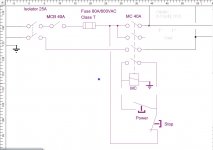dazz
Stainless
- Joined
- Aug 20, 2006
- Location
- New Zealand
Hello
One way to connect the start/stop control switches is shown in the picture.
The switches will open/close the main supply contactor for a machine tool. In this case, a lathe.

The problem with this is that it takes line voltage out to the on/off switches.
I'd like to keep all line voltage within the electrical controls enclosure and have only 24V going out to the switches.
There are a few constraints:
The contactor has line voltage coils and that won't change.
I want all power to be drawn through the contactor, so having a separate always-on 24V supply before the contactor is at least undesirable.
If I have to use the circuit in the picture, I will armour the on/off switch cables.
Any suggestions?
One way to connect the start/stop control switches is shown in the picture.
The switches will open/close the main supply contactor for a machine tool. In this case, a lathe.

The problem with this is that it takes line voltage out to the on/off switches.
I'd like to keep all line voltage within the electrical controls enclosure and have only 24V going out to the switches.
There are a few constraints:
The contactor has line voltage coils and that won't change.
I want all power to be drawn through the contactor, so having a separate always-on 24V supply before the contactor is at least undesirable.
If I have to use the circuit in the picture, I will armour the on/off switch cables.
Any suggestions?



